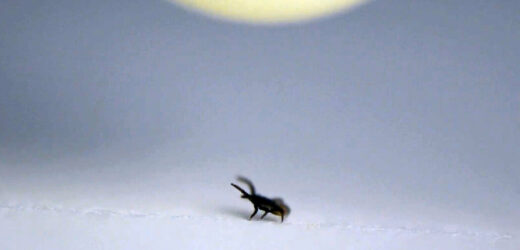Most people try, or at least hope, to avoid ticks. The tiny arachnids spread a variety of harmful diseases, as they expand their range to new areas. But two scientists recently set out on a counterintuitive mission to collect as many bloodsucking ticks as possible.
“We had quite a few nice afternoons of frolicking around forests with bedsheets,” Sam England, a biologist at the Natural History Museum in Berlin, said. “Just dragging them, picking up the ticks.”
He and Katie L. Lihou, friends and doctoral students at the University of Bristol in England at the time, were attempting to combine their research topics into a single collaborative project. Dr. Lihou is a veterinary parasitologist who studies ticks, and Dr. England is an ecologist who studies electricity and electroreception.
The resulting paper, published Friday in the journal Current Biology, provides a new reason to worry about ticks. The scientists demonstrate that the static electric fields naturally produced by animals (including humans) can physically yank the ungainly creatures onto their hosts. By electrically extending their reach, ticks may be able to grab hold of hosts more easily. While the finding may add to ticks’ terrifying attributes, this knowledge could also be used to improve antistatic tick defenses.
Many a tick researcher has had to chase down an errant arachnid after it was flung about by static from plastic or nylon equipment because of static, said Sukanya Narasimhan, a biologist at Yale University who was not involved with the new study. But popping ticks were considered nothing more than a nuisance; “we’ve never given it much thought,” Dr. Narasimhan said.
To better understand what was happening, Dr. England and Dr. Lihou brought their ticks into a tightly controlled environment that attempted to mimic conditions they face when questing for a blood meal.
When a tick looks to feed, it stands atop a plant that is grounded, which means its electrical charge is dissipating down into the earth. To simulate this condition, the ticks were placed on a grounding plate. The researchers then passed an electrode, was charged to 750 volts, three millimeters over the ticks. This voltage is similar to or even lower than that of a typical mammal’s electric field. The ticks were invariably pulled upward against gravity onto the electrode. Holding the parasites close to a similarly charged rabbit’s foot produced the same flying tick phenomenon.
To get a sense of what this animal attraction might mean for a potential tick host in nature, Dr. England designed a computer model of the electrical field around a cow.
“The geometry of a cow is very complicated,” Dr. England said, so he used a technique that breaks up the dimensions into smaller elements, making it easier to develop a model for the entire cow’s electric field.
This model revealed that the static charge of a passing bovine could exert considerable attractive force on a tick searching for food atop a blade of grass a few millimeters away. And another experiment testing the minimum force required to attract ticks found that a 30-kilovolt surface charge — which is extreme but theoretically possible in humans — could vacuum up ticks as far as several centimeters away.
The ticks could be attracted to electric fields because they themselves are accumulating static charge as they creep and crawl through the world. If that’s the case, you’d expect them to be attracted to fields of opposite charge but repelled by fields of the same charge — but Dr. England and Dr. Lihou found that ticks are attracted to both positive and negative electric fields. This finding suggests that the ticks are polarized in some way, meaning positive and negative charge are separated in their bodies, but how exactly that polarization works is still unclear.
Dr. Narasimhan said the results were “super interesting,” but she cautioned that we can’t say for sure whether static electricity plays a role in the tick life cycle until it has been confirmed with live hosts outside of the lab. Dr. England agreed, suggesting a future experiment where some sheep go through a “carwash of antistatic spray,” while others don’t, would be “quite a funny idea,” he said.
But he also added that he’d be “very surprised if it doesn’t happen in nature.” Whether in the field or in the lab, he said, “the physics doesn’t change.”
Source: Read Full Article


